The few days I stayed in a tent with the villagers above Namche Bazar was on one hand a very sad experience, but on the other hand an exciting and somehow enriching experience. Especially in terms of what we Westerners could learn from the Sharpas! As mentioned, it was just amazing to see how these mountain people were able to manage this difficult situation after the second big earthquake. It just looked that this was part of their life, and it was…
On the second day, I went down to the school and was looking for Lhakpa’s two children. I have been informed that the school will be closed again (they closed it already after the first earthquake), which is a good thing in this situation. So they informed all the parents to pick up their children, since it was a boarding school, where children would not only take classes, but also stay there during the academic year. In this school, just like in Thame, the classrooms could not be used anymore because of the earthquake, so school life took place in tents, but this was now also too dangerous.
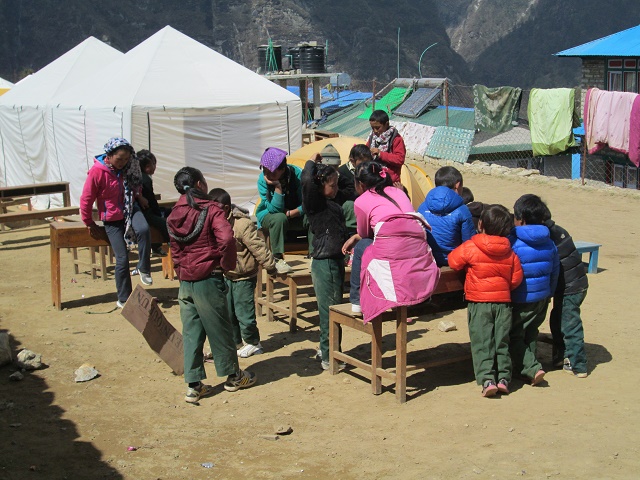 The children are waiting to be picked up by their parents in front of the school tents in Namche Bazar
The children are waiting to be picked up by their parents in front of the school tents in Namche Bazar
 A happy moment: Lhakpa’s wife Jangmu found son Tensing Jangbu (front row to the right)
A happy moment: Lhakpa’s wife Jangmu found son Tensing Jangbu (front row to the right)
 Lhakpa picking up his daughter Lhakpa Kiki – Luckily, nobody in the family got hurt in the second earthquake
Lhakpa picking up his daughter Lhakpa Kiki – Luckily, nobody in the family got hurt in the second earthquake
After looking for a while, I finally found the two children and was happy to learn that Lhakpa and his wife were on the way to pick them up. Finally, they arrived, and once again, it was a wonderful moment for me to see the whole family together. We spent some time together and later on they decided to leave Namche Bazar and hike to the next village, where they also had some relatives. I stayed on more night in my tent above Namche Bazar with all the other villagers and left the next day to go back to Samde, the village were Lhakpa and his family lives. During the next few days I was with Lhakpa’s family again and I tried to help as much as I could, mostly helping to fix some of the broken stone fences. The reason for that was that all the Yaks are usually out in the wild and they will go wherever the “grass is the greenest”, and move from one field to another. So it is I important to keep them out from your piece of land, especially, if you have also potato fields which was the case for Lhakpa’s family.
 Another house of Lhakpa’s relatives that is badly damaged – This happened in the second earthquake
Another house of Lhakpa’s relatives that is badly damaged – This happened in the second earthquake
 Fixing the stone fences – How long will they really hold?
Fixing the stone fences – How long will they really hold?
 Trying to help as much as I can, even if it is on a small scale
Trying to help as much as I can, even if it is on a small scale
Later on we hiked one more time up to Thame since I was interested to see, how the second earthquake had affected this already very severely damaged village. Once we arrived, I was shocked how terribly the second earthquake damaged the few houses that where still standing after the first earthquake. Looking around, I could not see one single building that was not damaged. But I did see at least one good thing: The Red Cross tents had finally also arrived up here in this remote mountain village. I was so glad for the people, especially when I saw many of the high quality German Red Cross family tents. They were big, strong and very stable which will help the people up here in this high altitude, and especially during the upcoming Monsoon.
 Finally, the big and strong German Red Cross tents have now also arrived in Thame – They are really needed here
Finally, the big and strong German Red Cross tents have now also arrived in Thame – They are really needed here
 And everybody in Thame now lives in tents since even new houses are too dangerous to use
And everybody in Thame now lives in tents since even new houses are too dangerous to use
 Even well build guesthouses are totally damaged - In this one I have spent a few nights before the earthquake
Even well build guesthouses are totally damaged - In this one I have spent a few nights before the earthquake
 This was a potato field at one time…
This was a potato field at one time…
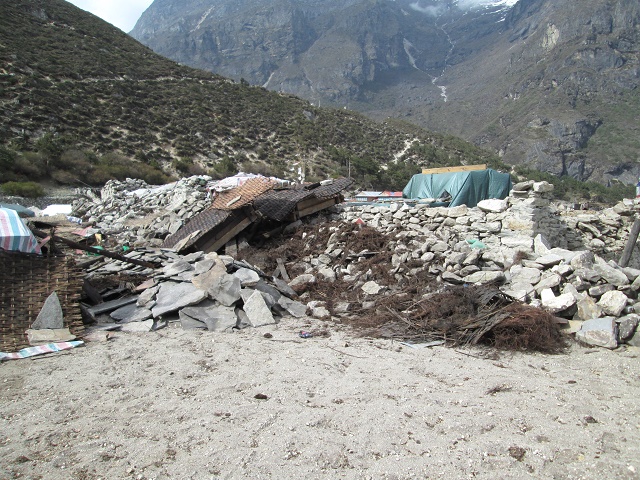 The house we tried to stabilize a little bit a week ago is now more or less gone
The house we tried to stabilize a little bit a week ago is now more or less gone
 And as older the house, as more damaged it is…
And as older the house, as more damaged it is…
Shocked and sad again because of what I have seen again up there, Lhakpa and I came to the decision, that nothing could be done at this point in time. We left the village and went back to his house and tried to stabilize some of the walls in his house. The second earthquake had damaged his wall in the front of the house (it is mostly gone…), but more seriously, the foundation of his house underneath the living room is severely damaged. This looked very serious and Lhakpa told me he thinks that this part of the house will collapse if there is another earthquake. Unfortunately, I had to agree with him and we tried to stabilize the wall with some wooden pillars. It was somehow a desperate act, but that is all we could do at this point. Later he showed me the living room and once again, I realized that the second earthquake hat moved the already damaged wall even more and it was now really leaning inwards in a very dangerous angle. It could collapse anytime. This part of the house was definitely too dangerous to use. All in all, the second earthquake damaged this new house in a way that it cannot be used anymore until most of the walls have been fixed, and this will take several months. This also means that the whole family, like many more in the area, will sleep in a tent during the next few months, which is also Monsoon season. What a sad and terrible situation!
 Lhakpa’s new house has also been more damaged by the second earthquake - The stone fence in the front yard is now gone
Lhakpa’s new house has also been more damaged by the second earthquake - The stone fence in the front yard is now gone
 The wall in the living room is now leaning dangerously inwards – It cold collapse any time
The wall in the living room is now leaning dangerously inwards – It cold collapse any time
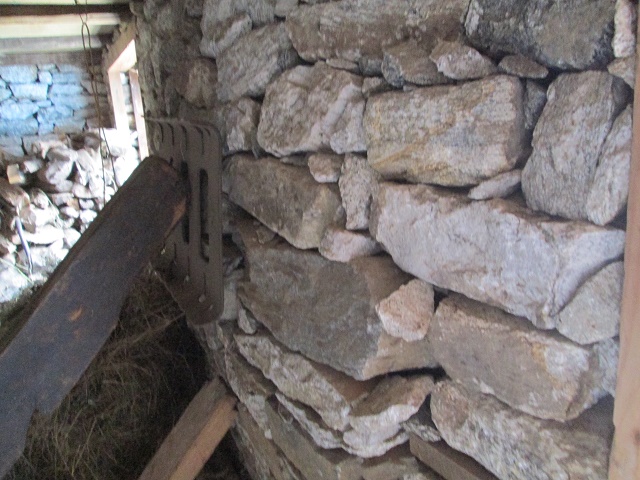 And the most scary thing – The foundation wall underneath the house is also not stable anymore
And the most scary thing – The foundation wall underneath the house is also not stable anymore
 And there are many more cracks in the walls – A sad perspective for the future…
And there are many more cracks in the walls – A sad perspective for the future…
During the next few days I stayed with Lhakpa’s family, I realized that there is not much I could do in this part of the country, since many people, just like him, had to wait until the specialist for the walls arrived. However, since there are so many houses to fix it will take several months. Also, it depends if there are any additional earthquakes, which hopefully will not be the case. Later on, some locals advised me to leave this high altitude area before the rain starts since they expect landslides which may make the only trail up to these villages unpassable. Based on this advice and the always present fear of another earthquake which could block all trails, I finally decided to leave this area and the wonderful people and start my long hike down to Lukla and then later to Kathmandu. I did not know exactly when and how, but at least I had a plan.
When the day finally came, I had to say good bye to Lhakpa and his family, a very sad moment for me, but I knew that I would come back later this year to help them. For now, I finally took my backpack and started the long and steep way down, a trail this strong mountain people are using every day. Even when they go shopping at the market in Namche Bazar, it takes them at least two hours one way and they carry everything back to their homes in a backpack or a certain load on their back, for example a 30kg/66lb bag of rice… So I knew that I had nothing to complain with my 20kg/44lb backpack, even when I expected that my trip will take me at least seven to eight hours (it is usually a two-day hike). I made a last stop in Namche Bazar to say good bye to some if the people I know there, and off I was. The first part was very steep and there was only limited damage to the trail and the weather was OK. Later on, the rain started and the trail and many houses along the way had been damaged very badly by the second earthquake. I remember that this was not the case after the first earthquake, but the epicenter of the second earthquake was much more close to this area. There were fallen trees, many landslides and a lot of rocks that came down from the nearby cliffs. There were also open cracks from the earthquake and it was raining… Which means that the water will go into these cracks and this could cause landslides, something everybody was talking about. In fact as lower I came in the valley, I realized, that the second earthquake hat already produced many landslides on these steep mountain slopes, and it was just a matter of time, when the next once will come down. Based on all this, I tried to move even faster and the rain was really not helpful in this process. Also, I was really scared to traverse some areas, especially the landslides, but there was no other way at that time, so I tried to pass these dangerous areas very fast, always looking up to the at times overhanging rocks. It was definitely not a good feeling and at time I was really scared…
 Saying good bye to Lhakpa’s family was a sad moment – But I know that I will be back here again soon
Saying good bye to Lhakpa’s family was a sad moment – But I know that I will be back here again soon
 On the way down – The conditions for some families were just unbelievable; all I could do is to give them some money
On the way down – The conditions for some families were just unbelievable; all I could do is to give them some money
 Despite the terrible situation, the children seem always to be in a positive mood
Despite the terrible situation, the children seem always to be in a positive mood
 As lower as I come, as worse gets the trail
As lower as I come, as worse gets the trail
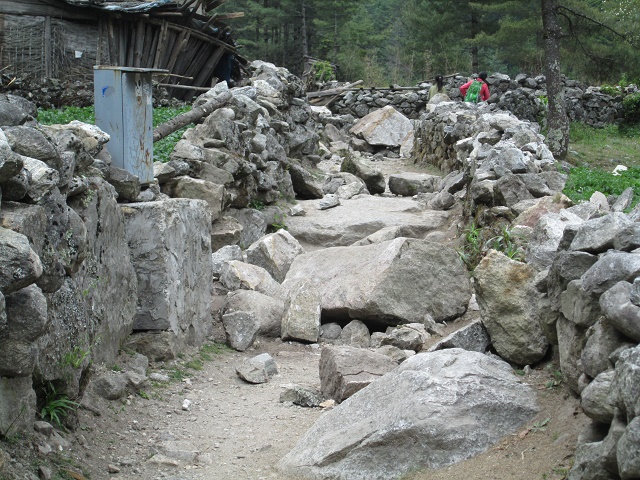 Yes, the trail down had really changed…
Yes, the trail down had really changed…
 And this trail became more and more difficult to use
And this trail became more and more difficult to use
 Many more houses had also been destroyed
Many more houses had also been destroyed
 Many landslides from the earthquake which were sometimes impossible to cross
Many landslides from the earthquake which were sometimes impossible to cross
 The trail is gone – No way to pass here
The trail is gone – No way to pass here
 My two new friends are showing me the way…
My two new friends are showing me the way…
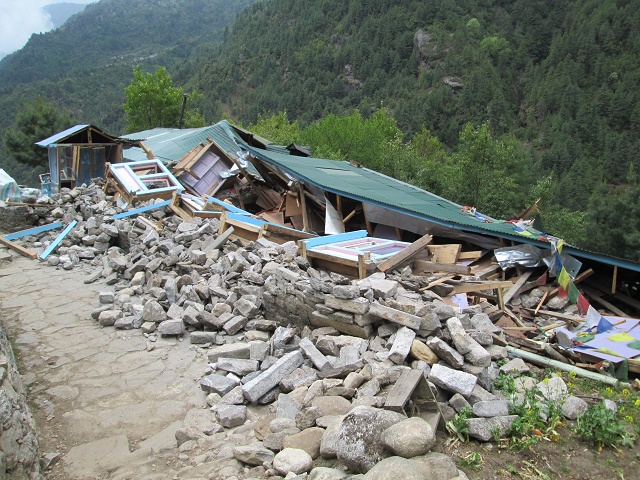 Along the way I see terrible destruction…
Along the way I see terrible destruction…
 As well as beautiful and curious eyes…
As well as beautiful and curious eyes…
Finally, after about seven hours I arrived in Lukla. The rain never stopped, so I was glad to go into a guesthouse, change my wet clothes and finally drink a warm tea. What a good feeling after such a long and at times very scary hike. Next was to find out if there will be some flights to Kathmandu the next morning. After checking all this, I had been informed that I should report at 6:00am at the airport and we will go from there. Lukla is a very difficult airport to fly in and the weather window for the planes is often only about two hours per day, and very early in the morning. Sometimes, there are no flights, so it is always good to have some spare days, or, you can do a six day hike and one day bus ride to Kathmandu. Time was not my problem, so I decided to stay at least one night in Lukla and check the flight conditions early in the morning. The next decision was where to sleep: in a tent or in the guesthouse. I have now slept for several weeks in a tent, just like most locals, because there have been so many aftershakes during the last few weeks, and everybody was afraid to spend the night in a house. This guesthouse, however, was made out of wood, and I decided to sleep on the ground floor. It was a strange feeling since I tried to sleep with all my clothes on, including my shoes, very near the door, which I did not lock and my backpack was ready to go. I am not sure if it was a good idea, since I was not really able to sleep and I was up again much before 5:00am and went to the airport at 6:00am, as instructed. Once there, they informed me that they don’t know yet when and if the planes will arrive. However, I should just check-in and wait. As longer as we waited as worse the weather seem to look. Huge clouds covered the area including the airport. Being a pilot myself, I knew that there was no way that any plane could land in this challenging mountain airport in this kind of weather conditions. But then, weather conditions can change very fast in the mountains, this this happened at one point and they informed us that some planes took off in Kathmandu and that they should be here in about 40 minutes. Well, at the moment when they arrived in this valley, the clouds had returned and they had to land on a nearby airport. It seemed that everything had to be challenging on this trip, even a flight out of the Himalayas. But once again, that is just part of the journey and that is how I took this ever changing situation: It is the journey, not the destination! If there is no plane today, there may be one tomorrow. Nevertheless, as most of the time, things work out and about five hours later I was sitting in a small Twin Otter plane over the clouds and was wondering what I will have to expect in Kathmandu this time and after the second big earthquake…
 Finally in Lukla after a seven hour hike – No tourist is here anymore
Finally in Lukla after a seven hour hike – No tourist is here anymore
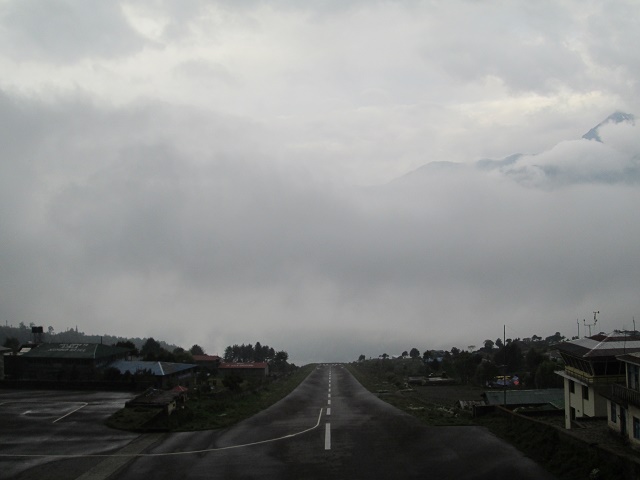 Yes, this is definitely not flying weather…
Yes, this is definitely not flying weather…
 Finally, it clears up and Tara (Air), the “Goddess of Peace and Protection”, arrives to bring us back
Finally, it clears up and Tara (Air), the “Goddess of Peace and Protection”, arrives to bring us back
 And to close on a positive note, yes, it is not easy to open a “Ricola” candy…
And to close on a positive note, yes, it is not easy to open a “Ricola” candy…


